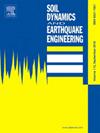Evaluation of strongest ground motions under strike-slip rupture for the Luding and Imperial Valley earthquakes
IF 4.2
2区 工程技术
Q1 ENGINEERING, GEOLOGICAL
引用次数: 0
Abstract
Strong ground motions can yield serious disasters to engineering structures and geotechnical slopes in the vicinity of surface rupture. In this work, based on 189 sets of strong motion records from the Mw6.6 Luding and Mw6.5 Imperial Valley strike-slip earthquakes with similar magnitudes, the strongest horizontal ground motions are obtained via the rotation technique, and the spatial motion distributions, seismic spectra and attenuation characteristics under similar focal mechanisms are analysed. Our research results indicate that the characterization parameters of ground motion are correlated with the degree of earthquake damage in high-intensity regions. The pulse-like ground motion generated by the unilateral rupture of the strike-slip seismic fault is stronger and the directional effect is more obvious than that generated by the bilateral rupture. Although the peak acceleration and peak ratio of the strongest ground motion in the Imperial Valley and Luding earthquakes are similar, the Arias intensity is formed by energy accumulation in the former is approximately three times that in the latter. The high-amplitude response velocities of the Luding and Imperial Valley earthquakes are elliptical around the epicenter and zonally distributed along the fault at the front end of the rupture, respectively. The spectral value and characteristic period of the velocity pulse of the Imperial Valley earthquake are significantly greater than those of the Luding earthquake, and the spectral value of the near-fault pulse-like ground motion exceeds the seismic design code for the basic earthquake within the local natural vibration period, which also increases the seismic design requirements for engineering structures in medium and long periods. The study of strong ground motions of strike-slip rupture fault not only contributes to quickly formulating corresponding disaster relief plans for seismic events but also provides valuable data support for future seismic risk analyses and earthquake disaster prevention.
泸定和帝王谷地震走滑破裂条件下的最强地面运动评价
强地震动会对地表破裂附近的工程结构和土工边坡造成严重的灾害。基于189组相似震级的鲁定Mw6.6和皇谷Mw6.5走滑地震强震记录,利用旋转技术获得了最强的水平地震动,并分析了相似震源机制下的空间运动分布、地震谱和衰减特征。研究结果表明,在高烈度地区,地震动表征参数与震害程度相关。走滑地震断层单侧断裂产生的脉状地震动比双侧断裂产生的脉状地震动更强,定向效应更明显。虽然帝王谷地震和泸定地震最强地震动的峰值加速度和峰值比相似,但前者由能量积累形成的阿里亚斯烈度约为后者的3倍。泸定地震和帝王谷地震的高振幅响应速度在震中周围呈椭圆形,在断裂前端沿断层呈带状分布。帝王谷地震的速度脉冲谱值和特征周期明显大于泸定地震,近断层脉状地震动谱值在局部自振周期内超过了基本地震的抗震设计规范,这也增加了对工程结构中长期的抗震设计要求。研究走滑破裂断层的强地震动,不仅有助于快速制定相应的地震事件救灾方案,而且为今后的地震风险分析和地震灾害防治提供有价值的数据支持。
本文章由计算机程序翻译,如有差异,请以英文原文为准。
求助全文
约1分钟内获得全文
求助全文
来源期刊

Soil Dynamics and Earthquake Engineering
工程技术-地球科学综合
CiteScore
7.50
自引率
15.00%
发文量
446
审稿时长
8 months
期刊介绍:
The journal aims to encourage and enhance the role of mechanics and other disciplines as they relate to earthquake engineering by providing opportunities for the publication of the work of applied mathematicians, engineers and other applied scientists involved in solving problems closely related to the field of earthquake engineering and geotechnical earthquake engineering.
Emphasis is placed on new concepts and techniques, but case histories will also be published if they enhance the presentation and understanding of new technical concepts.
 求助内容:
求助内容: 应助结果提醒方式:
应助结果提醒方式:


